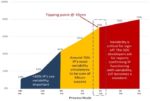Typically, there is an existential rift between the on-chip access requirements for test and the need for security in SoCs. Using traditional deterministic scan techniques has meant opening up full read and write access to the flops in a design through the scan chains. Having this kind of access easily defeats the best designed… Read More
Siemens EDA on the Best Verification Strategy
Harry Foster opened and wrapped a tutorial at DVCon 2022 on “The Best Verification Strategy You’ve Never Heard Of”. Harry started with a common refrain on verification; we face a crisis thanks to a combination of growing complexity in the systems we are able to design, yet double exponential growth in verification cost for… Read More
Scalable Verification Solutions at Siemens EDA
Lauro Rizzatti recently interviewed Andy Meier, product manager in the Scalable Verification Solutions Division at Siemens EDA. Andy is a product manager in the Scalable Verification Solutions Division at Siemens EDA. Andy has held positions in the electronics and high-tech fields during his 20-year career including: Sr.… Read More
Power Analysis in Advanced SoCs. A Siemens EDA Perspective
The success of modern battery-powered products depends as much on useful operating time between charges as on functionality. FinFET process technologies overtook earlier planar CMOS in part because they significantly reduce leakage power. But they exacerbate dynamic power consumption thanks to increased pin capacitances.… Read More
Faster Time to RTL Simulation Using Incremental Build Flows
I’ve been following Neil Johnson on Twitter and LinkedIn for several years now, as he has written and shared so much about the IC design and verification process, both as a consultant and working at EDA vendors. His recent white paper for Siemens EDA caught my eye, so I took the time to read through the 10 page document to learn… Read More
SIP Modules Solve Numerous Scaling Problems – But Introduce New Issues
Multi-chip modules are now more important than ever, even though the basic concept has been around for decades. With The effects of Moore’s Law and other factors such as yield, power, and process choices, reasons for dividing what once would have been a single SOC into multiple die and integrating them in a single module have become… Read More
MBIST Power Creates Lurking Danger for SOCs
The old phrase that the cure is worse than the disease is apropos when discussing MBIST for large SOCs where running many MBIST tests in parallel can exceed power distribution network (PDN) capabilities. Memory Built-In Self-Test (MBIST) usually runs automatically during power on events. Due to the desire to speed up test and … Read More
From Now to 2025 – Changes in Store for Hardware-Assisted Verification
Lauro Rizzatti recently interviewed Jean-Marie Brunet, vice president of product management and product engineering in the Scalable Verification Solution division at Siemens EDA, about why hardware-assisted verification is a must have for today’s semiconductor designs. A condensed version of their discussion is below.… Read More
DAC 2021 – Taming Process Variability in Semiconductor IP
Tuesday at DAC was actually my very first time attending a technical session, and the presentation from Nebabie Kebebew, Siemens EDA, was called, Mitigating Variability Challenges of IPs for Robust Designs. There were three presentations scheduled for that particular Designer, IP and Embedded Systems track, but with the COVID… Read More
DAC 2021 – Siemens EDA talks about using the Cloud
My third event at DAC on Monday was all about using EDA tools in the Cloud, and so I listened to Craig Johnson, VP EDA Cloud Solutions, Siemens EDA. Early in the day I heard from Joe Sawicki, Siemens EDA, on the topic of Digitalization.
Why even use the Cloud for EDA? That’s a fair question to ask, and Craig had several high-level… Read More









